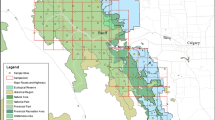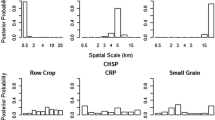Abstract
A large part of ecological theory has been developed with the assumption that intra- and inter-specific patterns of density and spatial distribution can be consistently and reliably compared, and that these patterns have represented populations across nonstudied landscapes. These assumptions are erroneous. We found that log10 population density estimates consistently decreased linearly with log10 spatial extent of study areas for species of terrestrial Carnivora. The size of the study area accounted for most of the variation in population estimates, and study areas increased with the female body mass of the study species. But study sites consistently had higher densities than can be expected for nonstudy sites, regardless of the size of the study area, because study sites are typically chosen based on a priori knowledge of high density. Inter-specific comparisons of density and distribution might provide more insight into community organization after intra-specific density estimates have been scaled by the study areas, and related to the nonstudied landscapes within each species' geographic range.
Similar content being viewed by others
References
Addicott JF, Aho JM, Antolin MF, Padilla DK, Richardson JS, Soluk DA (1987) Ecological neighborhoods: scaling environmental patterns. Oikos 49:340–346
Blackburn TM, Harvey PH, Pagel MD (1990) Species number, population density and body-size relationships in natural communities. J Anim Ecol 59:335–345
Boer PJ den (1981) On the survival of populations in a heterogeneous and variable environment. Oecologia 50:39–53
Brown JH, Maurer BA (1986) Body size, ecological dominance and Cope's rule. Nature 324:248–250
Connell JH, Sousa WP (1983) On the evidence needed to judge ecological stability or persistence. Am Nat 121:729–824
Cousins SH (1994) Taxonomy and functional biotic measurement, or, will the Ark work? In: Forey PL, Humphries CJ, Vane-Wright RI (eds) Systematics and conservation evaluation (Systematics Association special volume 50). Clarendon, Oxford, pp 397–419
Damuth J (1981) Population density and body size in mammals. Nature 290:699–700
Damuth J (1987) Interspecific allometry of population density in mammals and other animals: the independence of body mass and population energy-use. Biol J Linn Soc 31:193–246
Elton C (1933) The ecology of animals. Methuen, London
Garland T Jr (1983) Scaling the ecological cost of transport to body mass in terrestrial mammals. Am Nat 121:571–587
Greig-Smith P (1983) Quantitative plant ecology. University of California Press, Berkeley
Gittleman JL (1986a) Carnivore brain size, behavioral ecology, and phylogeny. J Mammal 67:23–36
Gittleman JL (1986b) Carnivore life history patterns: allometric, phylogenetic, and ecological associations. Am Nat 127:744–771
Hairston NG (1959) Species abundance and community organization. Ecology 40:404–16
Hanski I (1994) Spatial scale, patchiness and population dynamics on land. Philos Trans R Soc Lond B 343:19–25
Hersenstein P, Macdonald DW (1982) Some camparisons between red and arctic foxes, Vulpes vulpes and Alopex lagopus, as revealed by radio tracking. Symp Zool Soc Lond 49:259–289
Holling CS (1992) Cross-scale morphology, geometry and dynamics of ecosystems. Ecol Monogr 62:447–502
Keith LB (1983) Population dynamics of wolves. In: Carbyn LN (ed) Wolves in Canada and Alaska, their status, biology and management (Report series 45) Canadian Wildlife Service, Ottawa, pp 66–77
Kelker GH (1943) A winter wildlife census in Northeastern Wisconsin. J Wildl Manage 7:133–141
Kotlier NB, Wiens JA (1990) Multiple scales of patchiness and patch structure: a hierarchical framework for the study of heterogeneity. Oikos 59:253–60
Levin S (1992) The problem of pattern and scale in ecology. Ecology 73:1943–67
Mohr CO (1940) Comparative populations of game, fur and other mammals. Am Mid Nat 24:581–584
Morris RF (1955) The development of sampling techniques for forest insect defoliators, with special reference to the spruce budworm. Can J Zool 33:225–94
Odum EP (1953) Fundamentals of ecology. Saunders, London
Peters RH (1991) A critique for ecology. Cambridge University Press, Cambridge
Peters RH, Raelson JV (1984) Relations between individual size and mammalian population density. Am Nat 124:498–517
Pimlott DH (1967) Wolf predation and ungulate populations. Am Zool 7:267–278
Robinson JG, Redford KH (1986) Body size, diet, and population density of of neotropical forest mammals. Am Nat 128:665–680
Schonewald-Cox C, Buechner M (1991) Housing viable populations in protected habitats: the value of a coarse-grained geographic analysis of density patterns and available habitat. In: Seitz A, Loeschcke V (eds) Species conservation: a population-biological approach. Birkhauser, Berlin, pp 213–226
Schonewald-Cox C, Azari R, Blume S (1991) Scale, variable density, and conservation planning for mammalian carnivores. Conserv Biol 5:491–495
Smallwood KS (1994) Trends in California mountain lion populations. Southwest Nat 39:67–72
Smallwood KS, Fitzhugh EL (1993) A rigorous technique for identifying individual mountain lions Felis concolor by their tracks. Biol Conserv 65:51–59
Steele JH, Henderson EW (1994) Coupling between physical and biological scales. Philos Trans R Soc Lond B 343:5–9
Taylor LR (1961) Aggregation, variance and the mean. Nature 189:732–35
Taylor RAJ, Taylor LR (1979) A behavioral model for the evolution of spatial dynamics. In: Anderson RM, Turner BD, Taylor LR (eds) Population dynamics. Blackwell, Oxford, pp 1–28
Watt KEF (1971) Dynamics of populations: a synthesis. In: Den Boer P, Gradwell GR (eds) Dynamics of populations. Centre for Agricultural Publishing and Documentation, Wageningen, pp 568–580
Wiens JA (1989) Spatial scaling in ecology. Funct Ecol 3:385–97
Author information
Authors and Affiliations
Rights and permissions
About this article
Cite this article
Smallwood, K.S., Schonewald, C. Scaling population density and spatial pattern for terrestrial, mammalian carnivores. Oecologia 105, 329–335 (1996). https://doi.org/10.1007/BF00328735
Received:
Accepted:
Issue Date:
DOI: https://doi.org/10.1007/BF00328735




